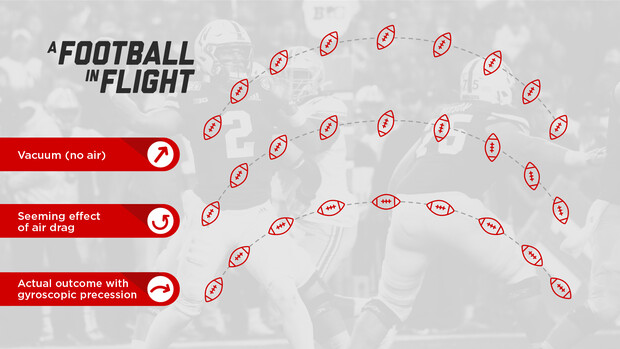Tim Gay, Nebraska’s football-physics expert, has solved the conundrum of why a well-thrown football behaves the way it does.
https://research.unl.edu/blog/tipping-point-after-20-years-gay-solves-conundrum-of-football-physics/The gyroscope of the problem
If a football were thrown in a vacuum, without any air to influence its flight, the phenomenon that so fascinated Gay wouldn’t exist. Instead, the ball’s nose would remain pointing upward even as gravity drew it back down to the field.
But introducing an atmosphere into the equation, or equations, means that physicists would expect to see notable changes in the flight of the ball as it sails through that air. The problem? What they expected is not what they saw.
Understanding why is a matter of forces and torques. Many of the forces are generated as the quarterback cocks his arm back, slings the ball forward and spins it off his fingers as he releases it. That motion propels the ball forward and up into the air, beginning the parabolic arc that the center of the ball will trace during a deep, well-thrown pass.
A tightly thrown spiral also rotates around the axis that runs from one tip of the football to the other, generating what’s known as angular momentum. When teaching the concept in class, Gay illustrates angular momentum by curling in the fingers of his right hand while sticking out his thumb. Whatever direction his thumb points is the direction of the angular momentum, with the curl of his fingers corresponding to the rotation of an object. The faster a football rotates, the greater its angular momentum — and in the case of a tight spiral, the direction of that angular momentum closely approximates the direction of the ball’s nose-to-nose axis.
As the arc of the ball’s trajectory dips below its initial launch angle, though, the torque generated by air rushing against it should, intuitively, cause the front end of the ball to pitch up so that it starts slowly tumbling backward, end over end.
“The reason it doesn’t happen is based on the concept of gyroscopic stabilization, and that’s where it gets difficult,” Gay said. “This illustrates how weird these kinds of problems are.”


